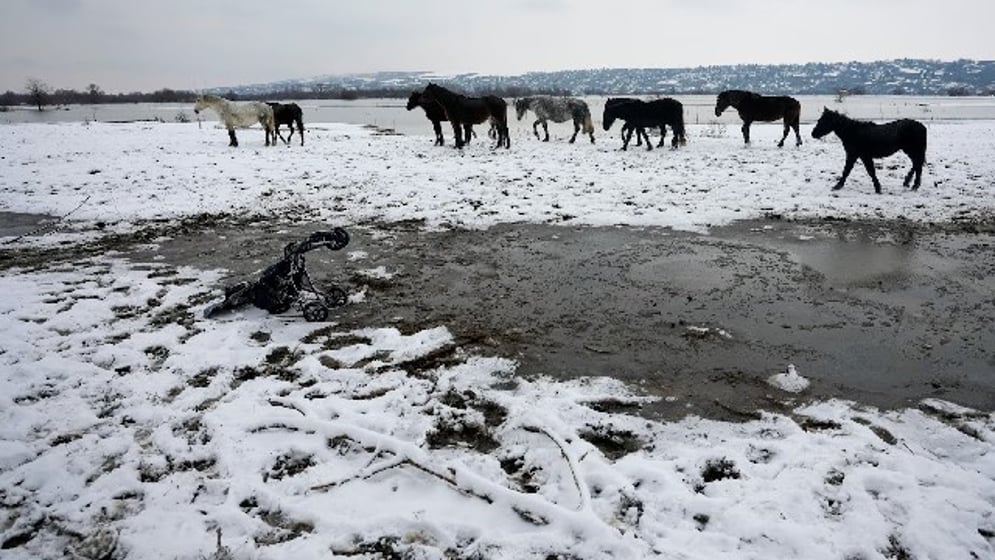In the heart of Europe, along the meandering path of the mighty Danube River, lies the enchanting Krcedinska Ada island, a serene sanctuary that, until recently, cradled a harmonious coexistence between humans and animals. Little did the inhabitants know that a tale of resilience and survival would unfold on this picturesque island, as the capricious hands of weather fate cast a shadow over its tranquil landscape.
Unveiling the Climatic Twist
As we delve into this narrative, the backdrop reveals a series of climatic twists that gripped Serbia in the latter part of the previous year. A prolonged period of unseasonable warmth lulled the local farmers into a deceptive sense of security. This masks the imminent threat brewing in the heart of the continent. Unbeknownst to them, the Danube, Europe’s grandest river, quietly swelled, fueled by the melting snow upstream, a precursor to the unfolding drama on Krcedinska Ada.
The Sudden Onslaught
The serenity of the island was shattered when the warmth gave way to a sudden onslaught of snowy and freezing weather, typical of the Balkan region. This abrupt shift caught the farmers, including Milenko Plavsic, off guard. Plavsic, a custodian of some of the island’s cattle, vividly describes the dire circumstances, stating, “The cattle are in jeopardy. Some died.” The usual routine of the animals navigating the shallow waters to return home. Their home was situated about 10 kilometers away, and it was disrupted by the swollen river and harsh conditions, leaving them hungry and vulnerable.
The Call to Action
In the face of this crisis, the resilient spirit of the Serbian people came to the forefront. Local authorities, recognizing the urgency of the situation, initiated a daring rescue mission. The island, now an unintentional fortress for nearly 200 stranded animals, became the focal point of a collaborative effort to bring them back to safety. The challenge was not just the physical barriers presented by the swollen river but also the logistical intricacies of evacuating 97 cows, 40 calves, and 70 horses from a distance of up to 3 kilometers from the shore.
Innovation and Compassion
The response was marked by innovation and compassion. A fenced river raft, an impromptu vessel of hope, was introduced to ensure the animals’ safety during transport. This initiative symbolized the commitment of the authorities and locals to safeguard every life stranded on Krcedinska Ada. The journey of rescue unfolded in stages, with multiple trips on river rafts guided by compassionate hands, ferrying the animals to the security of the mainland.
A Collective Sigh of Relief
As the first batch of cows and horses reached the shore, a collective sigh of relief swept through the community. Zoran Kunic, heading a cattle-breeders association in the area, encapsulated the sentiment, exclaiming, “Finally some good news!” The successful evacuation became more than just a logistical triumph; it became a testament to the resilience of nature, the indomitable human spirit, and the symbiotic relationship between the two.
Beyond Immediate Relief
This tale of resilience and rescue extends beyond the immediate relief efforts. It unveils the intricacies of the delicate balance between human activities and the natural environment. The farmers, authorities, and locals of Krcedinska Ada have unwittingly become stewards of a broader conversation about sustainable practices, environmental consciousness, and the profound impact of climate change on both wildlife and agriculture.
Reflecting on the Narrative
As we reflect on this gripping narrative, it beckons us to introspect and consider our role as custodians of the Earth. The events on Krcedinska Ada serve as a poignant reminder of the interconnectedness of all life forms and the shared responsibility we bear in safeguarding the planet.
Inspiration for Change
In the wake of the captivating tale of resilience and rescue on Krcedinska Ada, the narrative becomes more than just a recounting of events—it transforms into a catalyst for change, a call to action echoing through the corridors of our collective responsibility. This story is not merely an account of a crisis averted; it is an inspiration for a paradigm shift in the way we perceive and interact with our environment.
As the images of the stranded cows, calves, and horses finding solace on river rafts linger in our minds, there emerges a poignant invitation to embrace sustainable living practices. The island’s unexpected struggle underscores the fragile balance between human activities and the natural world. Let this serve as a wake-up call, urging us to reevaluate our ecological footprint and make conscious choices that resonate with the principles of sustainability.
The tale of Krcedinska Ada beckons us to reconsider our relationship with the environment, fostering a renewed commitment to environmental preservation. It reminds us that the consequences of climate change are not abstract; they are tangible and affect the very beings that share our planet. The melting snow upstream, the swollen Danube, and the ensuing weather extremes are not isolated incidents but interconnected threads in the fabric of our global ecosystem.
Conclusion
In conclusion, “Resilience and Rescue: A Compassionate Odyssey for the Stranded Animals of Krcedinska Ada” is not just a story, it is a testament to the strength of community collaboration, the adaptability of the human spirit, and the enduring bond between humans and nature. May it serve as a rallying cry for a world where compassion triumphs over crisis, and where every being, big or small, finds safety in the embrace of a caring community.
In response to this call for change, envision a world where every action, no matter how small, contributes to the preservation of our shared home. Embrace sustainable living as a personal responsibility, from reducing single-use plastics to embracing renewable energy sources. The story of Krcedinska Ada is a testament to the interconnectedness of all life forms, urging us to tread lightly on the Earth and leave a positive impact for future generations.

